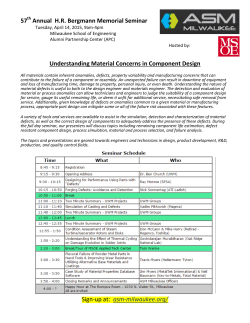
The risk of material degradation
The risk of reactor pressure vessel material degradation Doel-3/Tihange-2 Ilse Tweer NURIS 2015, Vienna, 16 -17 April 2015 Reactor pressure vessel – structural integrity • The reactor pressure vessel (RPV) is the central component of a nuclear ractor, - for safe operation of the NPP throughout service life RPV failure has to be excluded, because safety systems are not designed to cope with RPV failure • The structural integrity of the RPV has to be demonstrated until end of life (EOL) taking into account material aging (degradiation) by radiation effects and thermo-mechanical fatigue • Surveillance irradiation experiments are supposed to monitor neutron induced material embrittlement • Periodic in-service inspections (ultrasonic) have to ensure that the RPV steel does not contain cracks of a critical size 2 In-service inspections • In-service UT inspections worldwide cover only the the circumferential welds and a rather small neighboring base metal region, rather recently an underclad crack inspection is performed every 10 years 3 Detection of flaws in the RPVs of Doel-3/Tihange-2 • Doel-3 and Tihange-2 are PWR-type reactors in Belgium, operated by Electrabel, a GDF-SUEZ Group company (commercial operation since 1982/83) • Summer 2012: thousands of defects were found in the RPVs of Doel-3 and Tihange-2 during the first underclad-crack inspection after 30 years of operation • Size of the defects: mean 10 mm, maximum 24 mm • Position of the defects: parallel to the inner surface in about 120 mm depth, not symmetric • No comparable defects were found in the other worldwide 19 RPVs produced by the same manufacturer (RDM) 4 FANC activities • October 2012: technical meeting of the Belgian representatives of FANC, Bel V and AIB-Vinçotte, attended by experts from Finland, France, Germany, Japan, the Netherlands, South Korea, Spain, Sweden, Switzerland, the United Kingdom and the United States, and IAEA, OECD/NEA and EC. • January 2013: the findings of these three working groups were discussed during a two-day plenary assembly • May 2013: FANC (Federal Agency for Nuclear Control) authorized the restarting of both plants • March 2014: both plants were shut down because tests indicated that the mechanical properties of the material are more strongly influenced by irradiation than experts had expected 5 FANC information on flaw sizes/numbers in February 2015 DOEL-3 2012 2012_reinterpr. 2014 lower shell lower shell lower shell number of detected indications 7205 6936 11607 mean axial length of flaws (mm) 9,6 13,2 16 mean azimuthal length of flaws (mm) 7,6 11,7 12,7 maximum size of axial flaws (mm) 67,9 90,6 179 maximum size of azimutal flaws (mm) 38,4 47,2 72,3 6 Nature and origin of the defects Electrabel: • • Indications are caused by hydrogen flaking in the macro-segregation zone Defects are manufacture-induced, no growth during operation FANC: • • The hypothesis of manufacture-induced hydrogen flaking was adopted by FANC, although the acceptance inspection after manufacture did not show unacceptable flaw indications FANC required further experiments on mechanical properties and their radiation sensitivity, irradiation experiments should be performed using a rejected steam generator block (AREVA shell VB-395 with “similar” defects) W.F. Bogaerts, D.D. Macdonald (March 2015): • radiolytic hydrogen might diffuse into the RPV wall and induce development/growth of defects 7 Structural integrity assessment: pressurized thermal shock (PTS) analysis PTS analysis: comparison of the calculated load in case of an assumed transient on a postulated crack (stress intensity factor) with the materials properties (fracture toughness curve) For safe operation the fracture toughness has always to be higher than the load path (the diagram shows that in a certain region of the accident progress stress intensity factors are higher than the fracture toughness of the material, there exists the hazard of uncontrolled crack growth) 8 Structural integrity assessment radiation-induced embrittlement - handling of uncertainties • Electrabel proposed to add 50°C shift of the fracture toughness curve as safety margin covering all possible effects of defect density and irradiation • The International Expert Group recommended a 100°C shift (this recommendation was eliminated in FANC’s final report) • Electrabel performed several irradiation campaigns in the research reactor Mol (very high neutron flux) because the data from the first irradiation campaign did not show the expected results • The irradiation experiments were performed using samples from the AREVA shell VB-395, a rejected steam generator block. These samples cannot be considered to be representative for the RPV wall because the steel is certainly not identical, the manufacture processes and heat treatments are not identical and the AREVA block has no comparable operational history. 9 Irradiation Results (drawing published by Electrabel) 10 Summarizing conclusions • • • • • • A reactor pressure vessel with thousands of indications as found in 2012 in the RPVs Doel-3 and Tihange-2 would not be accepted for operation. The opinion of the licensee that the defects were induced during manufacture and did not develop/grow during operation is questionable since the defects were not observed during acceptance testing. There is no possibility to prove that the observed indications are due to hydrogen flakes. The recently reported increased number and size of indications indicates that development and/or growth of defects has occurred during operation. The uncertainties of actual material characteristics cannot be eliminated by the use of a random shift of the ductile-brittle transition temperature. A structural integrity assessment based on experimental data from nonrepresentative sample material cannot prove the safety of the RPV for reactor operation. 11
© Copyright 2025









